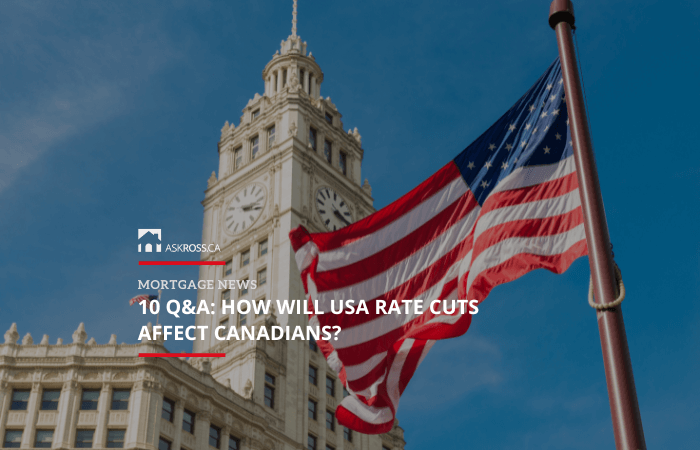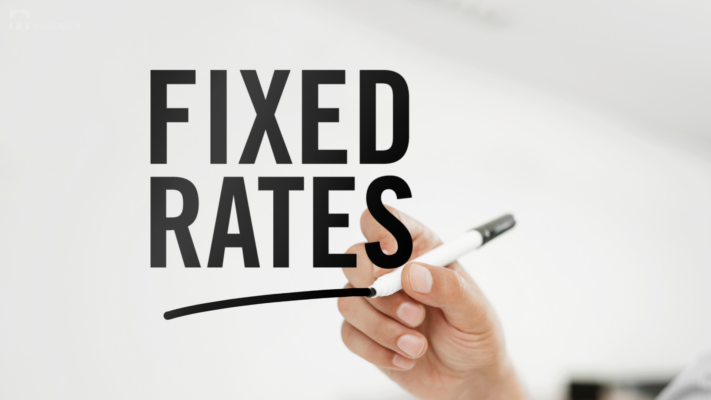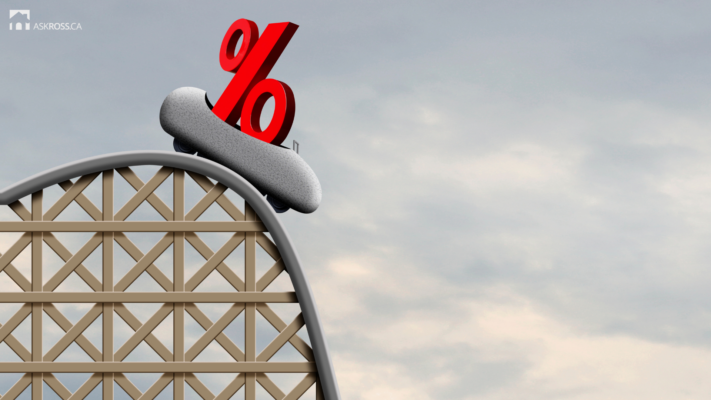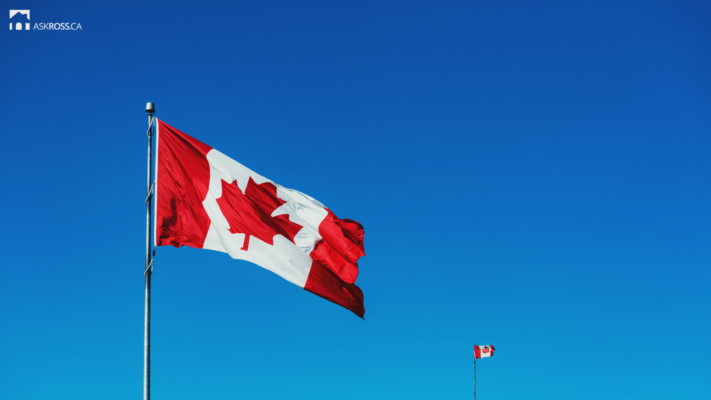
Published: September 17th, 2024 • Last Updated: September 18th, 2024
Author: Ross Taylor on AskRoss.ca
1. Why is the U.S. Federal Reserve’s rate cut important for Canada?
The buzz surrounding a potential shift in U.S. Federal Reserve policy is something we haven’t seen since the early 1980s. All year, economists have speculated about when exactly the Fed would start cutting
Our economies, Canada and the U.S. are tightly connected. You can think of it like plumbing—what happens to one country’s economy flows through the pipes and affects the other. So, when the Fed moves, policymakers like Bank of Canada Governor Tiff Macklem will be watching closely, as will I.
If the Fed makes a bigger move than expected, such as cutting rates by 50 basis points instead of 25, we could see the Canadian dollar strengthen against the U.S. dollar due to narrowing interest rate differences.
interest rates in 2024, leaving many borrowers on edge, waiting for the right moment.
It now looks like that moment is almost here, and the significance of this can’t be overstated—especially for Canadian mortgage rates.
Updated on September 18, 2024, the world’s most important Central Bank announced a 0.5% cut to it’s overnight policy rate today.
“We concluded that this was the right thing for the economy and the people we serve,” the Federal Reserve chair, Jerome Powell, said, referring to the central bank’s decision to cut interest rates by half a point. Here is a complete article on this from the New York Times.

2. Could a larger U.S. Fed cut push the Bank of Canada to act faster?
A bigger cut from the Fed might also push the Bank of Canada (BoC) to step up its own pace of rate cuts. If Macklem and his team see that the U.S. economy is weakening more than anticipated, that’s bad news for Canada.
We rely heavily on exports to the U.S., so any slowdown there will ripple through our economy. As one expert pointed out, a 50-basis-point cut by the Fed could open the door for the Bank of Canada to follow suit with its own 50-point cut, potentially as early as Octoberc this year.
Even if the Fed only cuts by 25 basis points, its tone matters just as much as the actual move. If Fed Chair Jerome Powell sounds dovish—essentially declaring “mission accomplished” on the inflation fight and signalling more cuts are imminent—it could drive bond yields lower. This matters because any move in U.S. treasury yields will influence Canadian bond yields, which are directly tied to our fixed mortgage rates.

3. Why should Canadians care about U.S. treasury yields?
When the Fed cuts what’s arguably the most influential interest rate in the world, it’s a clear sign that the U.S. economy is losing steam. Given our close economic relationship with the U.S., a slowdown there will hit Canada harder than most.
If the U.S. downturn takes a sharper turn, it’s possible that Canadian markets haven’t fully factored in just how much the Bank of Canada might need to drop its overnight rate to keep pace.
4. What are Canadian banks predicting?
Many Canadian banks, including CIBC, are already adjusting their outlooks. CIBC, for example, is now projecting a significant drop in Canada’s overnight rate, potentially as low as 2.25%.
That’s a substantial decrease from the BoC’s neutral rate estimate. CIBC is even forecasting two 50-basis-point rate cuts—one before the year ends and another in January. Their reasoning? A softening labour market, the burden of household debt, and looming mortgage renewals.

5. What does this mean for Canadian homeowners?
If CIBC’s predictions hold, this could bring significant savings for those with variable-rate mortgages. But here’s what’s surprising: despite the potential for these savings, many Canadians are still locking in fixed rates.
Why? Fear. The uncertainty surrounding rate hikes over the past few years has left many homeowners feeling burned. They’re nervous about the risk of another rate increase and aren’t willing to gamble.
However, the forecasts we’re seeing suggest that even a modest rate cut from the BoC—something around 125 basis points—could push variable rates below the lowest fixed rates currently available. Remember, the market is already pricing up to 200 basis points of rate cuts in the coming year.
To put that into perspective, a 200-basis-point drop would lower rates by about 40% from their current peak. This isn’t a rare phenomenon either—it’s a trend we’ve seen in about half of all rate-cutting cycles going all the way back to the 1970s.

6. Why are fixed rates still so popular?
Despite the data pointing towards significant rate cuts, many Canadians are still sticking with fixed rates out of caution. Homeowners remember the sting of rate hikes and don’t want to risk another one.
However, the numbers show that if even a modest easing by the BoC happens, variable rates could easily drop below today’s lowest fixed rates.
There’s also a psychological element to this. After years of rate hikes, many are hesitant to trust the forecasts, even when history suggests otherwise. And while it’s true that rate cuts aren’t a guarantee, the odds are looking increasingly favourable for those considering variable rates.

7. How likely are significant rate cuts?
Predicting rate cuts isn’t an exact science. While many economists believe we’re heading for significant cuts, it’s important to keep in mind that these predictions can vary. Statistically, the chance of a 200-basis-point cut lies somewhere between 20% and 80%.
But even the best forecasters can be wrong. In late 2021, for example, CIBC’s chief economist predicted 150 basis points in rate hikes for 2022 and 2023. In reality, the hikes were over three times that amount.
So, while the data seems to suggest a significant easing of rates, it’s always wise to be cautious. A healthy dose of skepticism can go a long way when making decisions based on predictions.

8. Should you consider a hybrid mortgage strategy?
If you’re nervous about going all-in on a variable-rate mortgage but still want to take advantage of potential rate cuts, there are ways to protect yourself.
One strategy is to opt for a hybrid mortgage, where part of your mortgage is at a fixed rate and part at a variable rate. This allows you to hedge your bets, reducing your exposure to rate hikes while still benefiting from rate drops.
For example, products like the Scotia STEP let you borrow part of your mortgage at a fixed rate and part at a variable rate. You can combine this with a Home Equity Line of Credit (HELOC), which allows you to make extra prepayments on the fixed-rate portion if rates drop significantly.
It’s a flexible strategy that can help you navigate both rising and falling rates.

9. What’s the bigger picture for Canadian homeowners?
For those of you with variable-rate mortgages, the prospect of significant rate cuts could bring some much-needed relief to your monthly payments.
As rates drop, more of your payment will go towards the principal, helping you pay off your mortgage faster. For those looking to renew their mortgage or purchase a new home, the possibility of falling rates is good news.
Fixed rates are expected to follow suit as bond yields continue to trend downward in anticipation of further rate cuts. But remember, fixed rates don’t react directly to Bank of Canada rate cuts. Instead, they follow bond yields. So, if you’re shopping for a fixed-rate mortgage, keep an eye on those bond yields.
What arebondyields?
When you buy a governmentbond, you’re essentially lending money to the government. Thebondyield is the return you get on that investment when thebondmatures. The 5-year Government of Canadabondyield is a key benchmark influencing 5-year fixed mortgage rates.

Final thoughts
While the outlook for rate cuts is promising, don’t bank on predictions alone. The past few years have shown us just how volatile the economic landscape can be. Even though economists seem confident that rates are coming down, it’s important to approach these forecasts with caution. If you’re looking for a balanced approach, the hybrid HELOC strategy might offer the flexibility you need.
Ultimately, whether you’re renewing, buying, or refinancing, it’s crucial to consider your unique financial situation before making any decisions.
If you’re unsure how these potential rate cuts could impact your mortgage, I’m here to help. Let’s review your mortgage strategy and ensure you’re in the best possible position to take advantage of these upcoming changes. Reach out anytime to explore your options and ensure your mortgage aligns with your long-term goals.

Ross Taylor Mortgages
If you want great service from someone you can trust – reach out to us today.
Get quick answers to your questions, no matter how difficult – 7 days a week.

 Apply For a Mortgage
Apply For a Mortgage